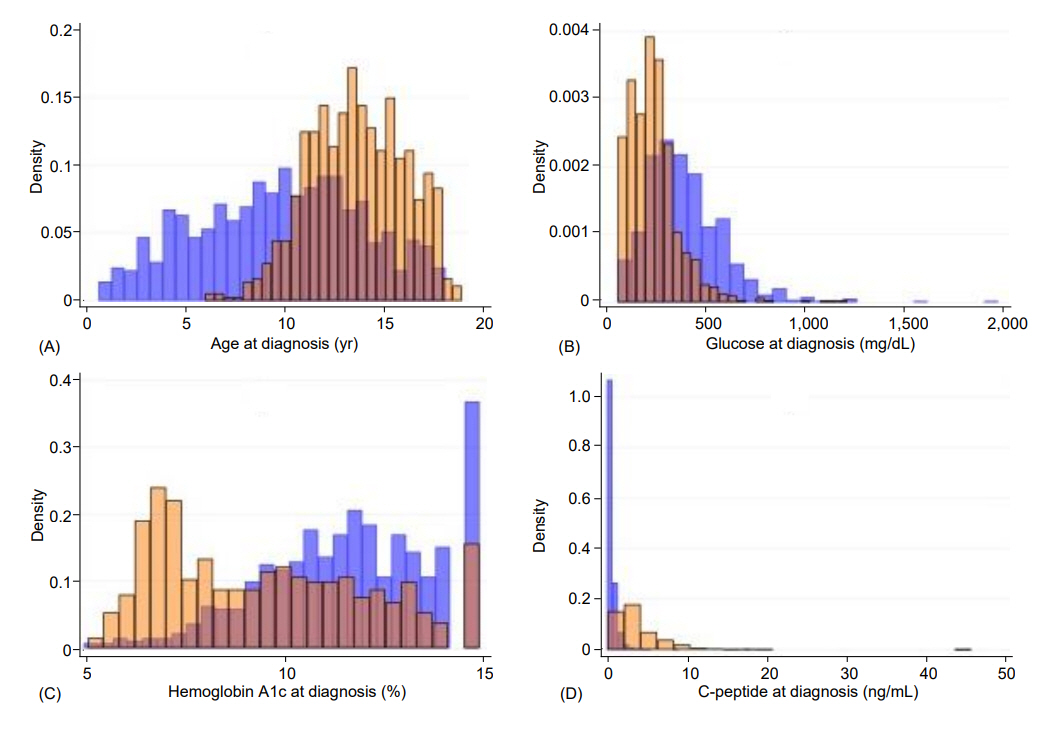Ann Pediatr Endocrinol Metab.
2022 Jun;27(2):121-125. 10.6065/apem.2142170.085.
Demographic and diagnostic markers in new onset pediatric type 1 and type 2 diabetes: differences and overlaps
- Affiliations
-
- 1St. Agnes Academy, Houston, TX, USA
- 2Baylor College of Medicine, School of Medicine, Houston, TX, USA
- 3Rice University, Houston, TX, USA
- 4Baylor College of Medicine, Texas Children’s Hospital, Houston, TX, USA
- KMID: 2531276
- DOI: http://doi.org/10.6065/apem.2142170.085
Abstract
- Purpose
Type 1 diabetes (T1D) is the most common type of diabetes in children, but the frequency of type 2 diabetes (T2D) is increasing rapidly. Classification of diabetes is based on a constellation of features that vary by type. We aimed to compare demographic, clinical, and laboratory characteristics at diagnosis of pediatric T1D and T2D.
Methods
We studied children who visited a large academic hospital in Houston, Texas (USA) with a new diagnosis of T2D (n=753) or T1D (n=758). We compared age, sex, race/ethnicity, presence of obesity, glucose, hemoglobin A1c, islet autoantibody positivity, C-peptide, and presence of diabetic ketoacidosis (DKA) at diabetes diagnosis.
Results
At diagnosis, children with T2D, compared with those with T1D, were older (13.6 years vs. 9.7 years), more likely female (63.2% vs. 47.8%), of racial/ethnic minority (91.1% vs. 42.3%), and obese (90.9% vs. 19.4%) and were less likely to have DKA (7.8% vs. 35.0%) and diabetes autoantibodies (5.5% vs. 95.4%). Children with T2D also had significantly lower glucose, lower hemoglobin A1c and lower C-peptide level (all comparisons, p<0.0001). In multiple logistic regression analysis, older age, racial/ethnic minority, obesity, higher C-peptide, and negative islet autoantibodies were independently associated with T2D (all, p<0.05), while sex, glucose, hemoglobin A1c, and DKA were not (model p<0.0001).
Conclusion
There are important demographic, clinical, and laboratory differences between T1D and T2D in children. However, none of the characteristics were unique to either diabetes type, which poses challenges to diabetes classification at diagnosis.
Keyword
Figure
Cited by 1 articles
-
Changes in metrics of continuous glucose monitoring during COVID-19 in Korean children and adolescents with type 1 diabetes mellitus
Hwa Young Kim, So Hyun Shin, Hyunju Lee, Jaehyun Kim
Ann Pediatr Endocrinol Metab. 2025;30(1):38-44. doi: 10.6065/apem.2448036.018.
Reference
-
References
1. Mayer-Davis EJ, Lawrence JM, Dabelea D, Divers J, Isom S, Dolan L, et al. Incidence trends of type 1 and type 2 diabetes among youths, 2002-2012. N Engl J Med. 2017; 376:1419–29.2. Pettitt DJ, Talton J, Dabelea D, Divers J, Imperatore G, Lawrence JM, et al. Prevalence of diabetes in U.S. youth in 2009: the SEARCH for diabetes in youth study. Diabetes Care. 2014; 37:402–8.3. Association AD. 2. Classification and diagnosis of diabetes. Diabetes Care. 2021; 44:S15–33.4. Mayer-Davis EJ, Kahkoska AR, Jefferies C, Dabelea D, Balde N, Gong CX, et al. ISPAD Clinical Practice Consensus Guidelines 2018: definition, epidemiology, and classification of diabetes in children and adolescents. Pediatr Diabetes. 2018; 19 Suppl 27:7–19.5. Liese AD, D'Agostino RB, Hamman RF, Kilgo PD, Lawrence JM, Liu LL, et al. The burden of diabetes mellitus among US youth: prevalence estimates from the SEARCH for Diabetes in Youth Study. Pediatrics. 2006; 118:1510–8.6. Jensen ET, Dabelea D. Type 2 diabetes in youth: new lessons from the SEARCH Study. Curr Diab Rep. 2018; 18:36.7. Siller AF, Tosur M, Relan S, Astudillo M, McKay S, Dabelea D, et al. Challenges in the diagnosis of diabetes type in pediatrics. Pediatr Diabetes. 2020; 21:1064–73.8. Redondo MJ, Rodriguez LM, Escalante M, Smith EO, Balasubramanyam A, Haymond MW. Types of pediatric diabetes mellitus defined by anti-islet autoimmunity and random C-peptide at diagnosis. Pediatr Diabetes. 2013; 14:333–40.9. Astudillo M, Tosur M, Castillo B, Rafaey A, Siller AF, Nieto J, et al. Type 2 diabetes in prepubertal children. Pediatr Diabetes. 2021; 22:946–50.10. Horwitz DL, Kuzuya H, Rubenstein AH. Circulating serum C-peptide. A brief review of diagnostic implications. N Engl J Med. 1976; 295:207–9.11. Rewers A, Klingensmith G, Davis C, Petitti DB, Pihoker C, Rodriguez B, et al. Presence of diabetic ketoacidosis at diagnosis of diabetes mellitus in youth: the Search for Diabetes in Youth Study. Pediatrics. 2008; 121:e1258–66.12. Praveen PA, Hockett CW, Ong TC, Amutha A, Isom SP, Jensen ET, et al. Diabetic ketoacidosis at diagnosis among youth with type 1 and type 2 diabetes: results from SEARCH (United States) and YDR (India) registries. Pediatr Diabetes. 2021; 22:40–6.13. Acevedo-Calado MJ, Pietropaolo SL, Morran MP, Schnell S, Vonberg AD, Verge CF, et al. Autoantibodies directed toward a novel IA-2 variant protein enhance prediction of type 1 diabetes. Diabetes. 2019; 68:1819–29.14. Urrutia I, Martínez R, Rica I, Martínez de LaPiscina I, García-Castaño A, Aguayo A, Calvo B, et al. Negative autoimmunity in a Spanish pediatric cohort suspected of type 1 diabetes, could it be monogenic diabetes? PLoS One. 2019; 14:e0220634.15. Klingensmith GJ, Pyle L, Arslanian S, Copeland KC, Cuttler L, Kaufman F, et al. The presence of GAD and IA-2 antibodies in youth with a type 2 diabetes phenotype: results from the TODAY study. Diabetes Care. 2010; 33:1970–5.16. Lawrence JM, Divers J, Isom S, Saydah S, Imperatore G, Pihoker C, et al. Trends in prevalence of type 1 and type 2 diabetes in children and adolescents in the US, 2001-2017. JAMA. 2021; 326:717–27.17. Van Name MA, Cheng P, Gal RL, Kollman C, Lynch J, Nelson B, et al. Consortium PD. Children and adolescents with type 1 and type 2 diabetes mellitus in the Pediatric Diabetes Consortium Registries: comparing clinical characteristics and glycaemic control. Diabet Med. 2020; 37:863–7.18. Carino M, Elia Y, Sellers E, Curtis J, McGavock J, Scholey J, et al. Comparison of clinical and social characteristics of canadian youth living with type 1 and type 2 diabetes. Can J Diabetes. 2021; 45:428–35.19. Adler A, Bennett P, Colagiuri Chair S, Gregg E, Venkat Narayan KM, Inês Schmidt M, et al. Reprint of: classification of diabetes mellitus. Diabetes Res Clin Pract. 2021; Jul. 31. 108972. https://doi.org/10.1016/j.diabres.2021.108972. [Epub].



